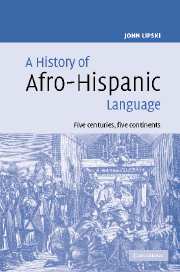Book contents
- Frontmatter
- Contents
- Acknowledgments
- Note on the Appendix
- Introduction
- 1 Africans in the Iberian peninsula, the slave trade, and overview of Afro-Iberian linguistic contacts
- 2 Early Afro-Portuguese texts
- 3 Early Afro-Hispanic texts
- 4 Africans in colonial Spanish America
- 5 Afro-Hispanic texts from Latin America: sixteenth to twentieth centuries
- 6 Survey of major African language families
- 7 Phonetics/phonology of Afro-Hispanic language
- 8 Grammatical features of Afro-Hispanic language
- 9 The Spanish-Creole debate
- References
- Index
4 - Africans in colonial Spanish America
Published online by Cambridge University Press: 24 February 2010
- Frontmatter
- Contents
- Acknowledgments
- Note on the Appendix
- Introduction
- 1 Africans in the Iberian peninsula, the slave trade, and overview of Afro-Iberian linguistic contacts
- 2 Early Afro-Portuguese texts
- 3 Early Afro-Hispanic texts
- 4 Africans in colonial Spanish America
- 5 Afro-Hispanic texts from Latin America: sixteenth to twentieth centuries
- 6 Survey of major African language families
- 7 Phonetics/phonology of Afro-Hispanic language
- 8 Grammatical features of Afro-Hispanic language
- 9 The Spanish-Creole debate
- References
- Index
Summary
This chapter will present historical data on the most significant African populations in Latin America, beginning with the areas in which the largest and linguistically most important concentrations were found during colonial times. These are the regions for which the greatest amount of written descriptions of Africans' speech is available.
Africans in colonial Peru
African slaves and their descendants were found in Peru from the earliest colonial periods to well into postcolonial independence, but the demographic distribution and geographical location varied across time, as did the interaction with speakers of Spanish. The use of African slaves had already been authorized for other areas of Spanish America, to replace dwindling indigenous workers, and African slaves were carried to the highland mines of Bolivia and Peru. Few demographic traces remain of these first African arrivals for several reasons. Nearly all were adult males, who were deprived of opportunities for procreation. Mortality rates were extremely high; the combination of altitude, cold temperatures, inadequate nourishment and harsh working conditions ravaged the slave population. At the same time, more stable nuclei of Africans began arriving in Cuzco and other developing colonial centers such as La Paz. As in other colonial towns, African slaves worked as domestic servants and artisans' assistants, living patterns which were conducive to learning Spanish, and to leaving some linguistic and cultural legacy.
- Type
- Chapter
- Information
- A History of Afro-Hispanic LanguageFive Centuries, Five Continents, pp. 95 - 128Publisher: Cambridge University PressPrint publication year: 2005



